Click on images to enlarge
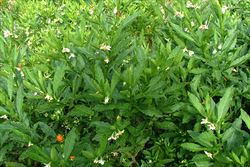
habit in flower (Photo: Sheldon Navie)
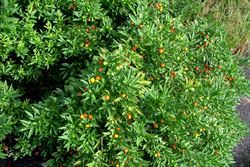
habit of large plant in fruit (Photo: Sheldon Navie)
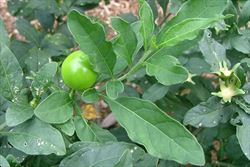
leaves (Photo: Sheldon Navie)
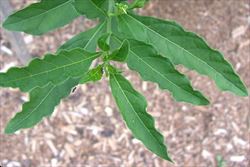
leaves with wavy margins (Photo: Sheldon Navie)
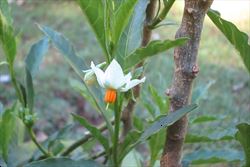
flower and older woody stems (Photo: Sheldon Navie)

immature fruit (Photo: Sheldon Navie)
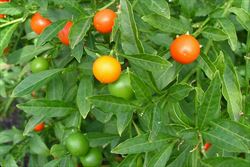
immature and mature fruit (Photo: Sheldon Navie)
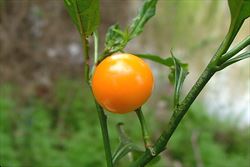
close-up of stem and mature fruit (Photo: Sheldon Navie)
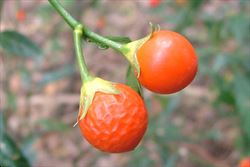
close-up of mature fruit (Photo: Sheldon Navie)
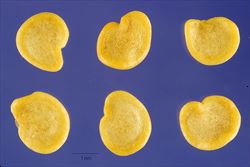
close-up of seeds (Photo: Jose Hernandez at USDA PLANTS Database)
Scientific Name
Solanum pseudocapsicum L.
Synonyms
Solanum capsicastrum Link ex Schauer
Family
Solanaceae
Common Names
capsicum weed, false capsicum, false Jerusalem cherry, Jerusalem cherry, Madeira cherry, Madeira winter cherry, Madeira winter-cherry, Madeira wintercherry, Natal cherry, orange poison berry, winter cherry, winter-cherry
Origin
Native to Mexico, Central America (i.e. Guatemala), the Caribbean (i.e. Trinidad and Tobago) and South America (i.e. Brazil, Bolivia, Ecuador, Peru, Argentina, Chile, Paraguay and Uruguay).
Cultivation
Madeira winter cherry (Solanum pseudocapsicum) is sometimes cultivated as a garden ornamental.
Naturalised Distribution
Widely naturalised in southern and eastern Australia (i.e. in south-eastern Queensland, New South Wales, Victoria, Tasmania and many parts of south-eastern and southern South Australia). Also occasionally recorded in northern Queensland and northern Western Australia.
Naturalised overseas in southern Africa, New Zealand, Hawaii and the USA (i.e. Texas, Louisiana, Mississippi, Alabama, Georgia, Florida, South Carolina, North Carolina, Connecticut, Massachusetts and New York).
Habitat
Most often a weed of closed forests, forest margins and waterways in temperate and sub-tropical regions, but is occasionally also found in semi-arid and tropical environments.
Habit
An upright (i.e. erect) herbaceous plant or small shrub usually growing 0.3-1 m tall, but occasionally reaching up to 2 m in height.
Distinguishing Features
- an upright herbaceous plant or small shrub usually growing 0.3-1 m tall.
- its alternately arranged leaves (2.5-10.5 cm long) are narrowly oval or elongated in shape with slightly wavy margins.
- its white star-shaped flowers (10-15 mm across) are borne singly or arranged in small clusters in the upper leaf forks.
- its fleshy fruit (10-15 mm across) turn from green to yellow and eventually bright orange-red as they mature.
Stems and Leaves
The younger stems and new growth is hairless (i.e. glabrous) or sparsely hairy (i.e puberulent). These branches are greenish and are usually somewhat ridged. Older stems may become woody and turn brownish in colour.
The alternately arranged leaves are borne on stalks (i.e. petioles) 2-15 mm long. These leaves (i.e. 2.5-10.5 cm long and 0.7-3 cm wide) are narrowly oval or elongated (i.e. lanceolate) in shape margins that are entire or slightly wavy (i.e. undulate). They are hairless (i.e. glabrous) or sparsely hairy with rounded to acute tips (i.e. obtuse or acute apices).
Flowers and Fruit
The star-shaped flowers (10-15 mm across) are borne singly or arranged in small clusters in the upper leaf forks (i.e. axils). These flowers have five green sepals (4-5 mm long) and are borne on stalks (i.e. pedicels) 3-10 mm long. They have five white petals (5-8 mm long) that are fused together at the base. They also have five stamens, with yellow anthers (2-4 mm long), and an ovary topped with a style (5-6 mm long) and stigma. Flowering occurs mainly from spring through to autumn.
The fruit is a rounded berry (10-15 mm across) and turns from green to yellow and eventually bright orange-red as it matures. Each fruit contains numerous white or pale yellow seeds (3-4 mm long).
Reproduction and Dispersal
This species reproduces mainly by seed, which are most often dispersed by birds and other animals that eat the fleshy fruit.
Environmental Impact
Madeira winter cherry (Solanum pseudocapsicum) is regarded as a significant environmental weed in Victoria and as an environmental weed in New South Wales.
Legislation
Not declared or considered noxious by any state government authorities.

